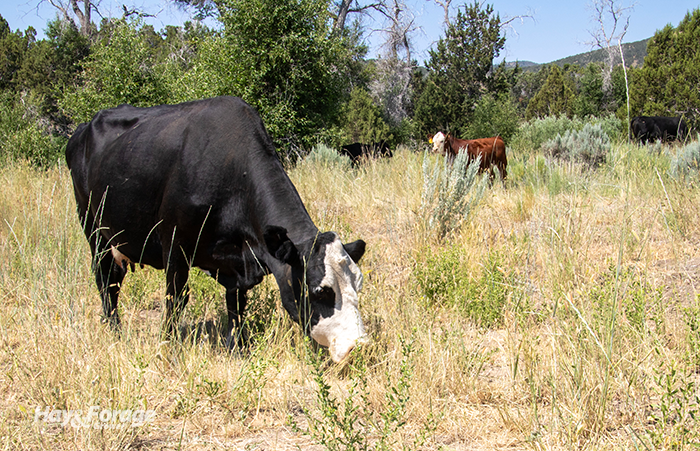
Grazing cattle can be easier and more effective when there is a plan to follow, but as most ranchers know, things don’t always go to plan. It can be even harder to adapt to ecological, environmental, and economical shifts when plans must comply with the regulations of grazing public land.
During a recent week-long trip out West, I spent a Wednesday morning with a cattle rancher in Rush Valley, Utah. He explained that the majority of his grazing acres are privately owned and have been for several generations, which is relatively rare for a rancher in his area. It’s more common to graze a much larger percentage of public land through agreements with the Bureau of Land Management (BLM).
Growing up and currently residing in the Midwest, I must admit that I am less familiar with this scale of agriculture and grazing legislature. For example, pasture stocking rate in my neck of the woods is defined by cows per acre. Western ranchers talk in terms of acres per cow.
Accessing natural resources like forage and water from public land is not a new concept, though, and grazing livestock on this ground is not a novel practice, either. In fact, the Multiple Use Sustained Yield Act was passed in 1960, and the Federal Land Policy and Management Act of 1976 is almost 50 years old. These laws laid the foundation for using, managing, and conserving timber, range, water, wildlife, and recreation for goods and services, including livestock production.
While only about 4% of land east of the Mississippi River is considered public, nearly 47% of land in the West — including the majority of states like Oregon, Nevada, and Utah — is owned by five federal agencies, led in acreage by the BLM and followed by the Forest Service, Fish and Wildlife Service, National Park Service, and Department of Defense. Renting pastures from a private landowner may be common practice in Wisconsin, but signing a lease with the government can be a much more restrictive agreement.
Taking new action
There are different types of BLM grazing permits, but term permits are the most popular. These permits can last up to 10 years, and they describe the species and class of livestock that will graze public land during a specific season. Term permits also include animal unit months (AUM), or the amount of forage needed to sustain one cow plus one calf for one month. Besides these parameters, though, term permits have historically overlooked the inevitable ups and downs of cattle farming.
Earlier this month, the Operational Flexibility Grazing Management Program Act was introduced to address concerns about these regulations. The bill offers ranchers options to adjust their approved plans for public land use by recognizing some of the challenges that come with grazing livestock.
Previous initiatives like the 2018 BLM Pilot Program have been created to account for changing weather patterns, market swings, and emergencies like droughts and wildfires. The Operational Flexibility Grazing Management Program Act would build upon the pilot program and include that the BLM provide permittees at least one alternative grazing option upon request. It also states that permittees can adjust their pasture rotations up to 14 days before or after the agreed upon start and end dates stated in their range management plans.
This flexibility will help ensure public land use continues to be a win-win-win situation for ranchers, their cattle, and the environment. The amount of forage on public land that is available for grazing supports greater levels of livestock production than what could be achieved if ranchers were limited to only grazing privately owned acres. In fact, the American Farm Bureau Federation (AFBF) estimates over $1 billion of all livestock sales is directly attributed to weight gain on public land forage.
On the flip side, cattle contribute to the landscape by controlling brush and invasive species, which helps prevent wildfires. Their grazing impact and hoof traffic can also improve forage growth and overall range conditions, help rejuvenate watersheds, and revive groundwater springs. These ecosystem services extend to other wildlife that thrive in healthier environments as well.
The bigger picture
The benefits of grazing public land encompass a broader audience when ranchers are added to the equation. For instance, livestock owners must maintain permanent fences and working facilities, keep culverts clear, and clean up trash or other foreign objects for the sake of their animals. This stewardship positively impacts the other pillars of public land use, like water quality and recreation. The AFBF notes permittees also serve as fire lookouts and are essentially the eyes and ears of public lands for local law enforcement.
In a statement released by Representative John Curtis of Utah regarding the Operational Flexibility Grazing Management Program Act, Kaitlynn Glover highlights the value of establishing more adaptive grazing plans. By acknowledging ranchers’ concerns and loosening some of the tight regulations, the executive director of natural resources at the National Cattlemen’s Beef Association suggests grazing agreements will better reflect agriculture’s role in public land preservation and conservation.
“Livestock grazing is one of the best and most cost-effective methods to prevent catastrophic wildfires on public lands, but so often, permittees are constrained by the overly burdensome federal management plans that restrict adaptive management,” Glover says. “This legislation ensures that federal lands ranchers are able to adapt their plans based on on-the-ground conditions and apply the best possible management to the landscape.”
The Operational Flexibility Grazing Management Program Act is currently under review by the Senate Committee on Energy and Natural Resources.

